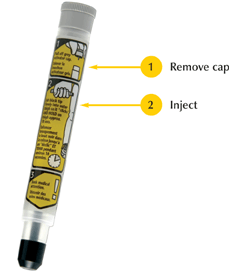How to Use an EpiPen (Video)

Everyone should know how to use an Epipen, whether you have allergies that warrant carrying one around with you, or not. Even if you don't know anyone else who carries one around with them, there may come a time when you encounter someone in a state of anaphylaxis -- if they are unable to administer their Epipen injection themselves, you could save their life by doing it for them. Using an EpiPen is very, very easy, and there just isn't an excuse for not knowing what to do if the need arises. If you're not sure what an Epipen pen is take a look at the following FAQs, and be sure to watch both instructional videos on How to Use an EpiPen.
Children's Allergy Books
What is an epipen?
Allergies are a way of life for many people, but few suffer to the point where anaphylaxis is possible. For those who have experienced anaphylactic shock, or those with the potential to do so, an Epipen is an auto-injector used to counter these reactions when and if they occur. The pen contains epinephrine (adrenaline), hence the name.
When should it be used?
Adrenaline is not something you want to inject into your body unless you know you're having an anaphylactic reaction to something. Believe me when I tell you that whether you have experienced anaphylaxis or not, you will know it's happening once a full-on reaction takes places. Some of these symptoms can include severe (and often fast-onset) swelling, severe itching, pain, and being unable to breathe. These can be reactions to bee stings allergies, peanut allergies, shellfish allergies and a host of others.
Note 1: They do expire, and you'll need to get a new one if that happens. I don't know what the maximum duration per batch is, but mine have always only been good for a year, so that may be the standard expiry date.
Note 2: You will need to hold the EpiPen in place for at least 10 seconds.
Video #1: How to Use an Epipen
Allergy-Free Cookbooks!
How to Use an Epipen
Step 1: Remove the pen from its container: At this stage you cannot accidentally inject yourself, because the cap at the back prevents the needle from deploying. All the same, don't get crazy with it.
Step 2: Remove the cap at the back: At this stage, the needle CAN be deployed, so be extra careful now.
Step 3: Find the meaty part of the outer thigh; do not simply jab this any old place, it should be injected into the muscle. If you have time to drop your pants first, do so -- if not, it should work through jeans and lighter materials.
Step 4: Place the needle side of the epipen against the meaty part of the outer thigh. It should be flush with the skin. Once there, press the plunger in until it pops/clicks, and then HOLD IT IN PLACE FOR A FULL COUNT OF 10. Remove when finished.
Step 5: Mind the needle once you're finished, as it will now be exposed.
Step 6: Call an ambulance in case you need further medical treatment.








